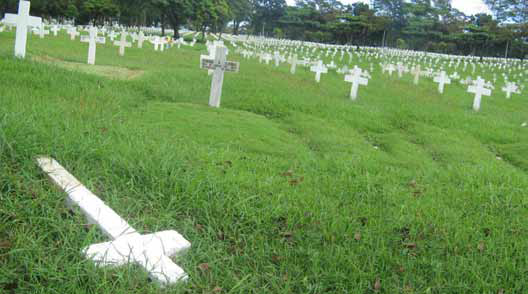
Libingan ng mga Bayani (Photo by Andrea Malaya Ragrario)
Archaeologists study human behaviour through material culture – the objects, structures, and other physical traces of human activities in a given area. Though we are also often known to study the past, many archaeologists would today argue that any study that take off from looking at material culture can be considered an archaeological study, whether it looks at past or present cultures.
A few years ago, me and a group of other young archaeologists took this perspective in order to study Philippine cemeteries. We recognized that cemeteries not only gives us a glimpse into our history (who was buried where, etc.), but into our culture and behaviour as well. How we treat the dead is more a reflection of the behaviour of the living (as the saying goes: the dead, after all, do not bury themselves), and culturally prescribed ideas of personhood, like one’s age, gender, and occupation; collective proprieties concerning values, notions of the body, supernatural beliefs; and social relations, say, between family members, religious groups, classes, affiliations, etc. These notions, whether we are aware of it or not, actually make their way into the material culture of death and burial – through grave markers, inscriptions, grave goods, burial structures, and even how the dead are arranged in the landscape.
This effort, under the supervision of Prof. Grace Barretto-Tesoro, has resulted in a book that will soon be published by the UP Press entitled “Himlayan, Pantiyon, Kampo Santo, Sementeryo: Exploring Philippine Cemeteries”. My contribution to the book about patriots’ graves includes a section on the Libingan ng mga Bayani. A part of me feels sorry that the research and writing of this chapter came a bit too early to have caught the controversy of Ferdinand Marcos’ burial at the Libingan, for these certainly reflect many of the historical and cultural concerns in which archaeology and heritage studies are interested. But there are many other well-studied articles online deal with this matter: the National Historical Commission of the Philippines has debunked Marcos’ claims of wartime gallantry, Mel Sta. Ana has explored the legal provisions that would prohibit the burial, Martial Law victims have used moral grounds to argue against it.
Given the particular fields and/or points of view from which these takes have emerged, it is not surprising that they rely heavily on documentary sources: archival documents, codified laws, and personal testimony. But social scientists know that what people say (or write) that they do may not be what they actually do. One way of uncovering these unarticulated cultural codes is by looking at our use of the material world around us – precisely the interest of archaeology.
It may not be apparent at ground level, but the Libingan ng mga Bayani is what archaeologists would call a concentric cemetery, in that it grows out of a central burial in a circular fashion. In the case of the Libingan, this central burial is the Tomb of the Unknown Soldier, found in the middle of the circular cemetery lay-out, and which presumably sets the values that this cemetery seeks to amplify. The scholar Benedict Anderson remarks that there are “[n]o more arresting emblems of the modern culture of nationalism [that] exist[s] than cenotaphs or tombs of Unknown Soldiers.” I may also add that anonymity is a crucial ingredient to qualify this concept of “nationalism” as one that rewards complete selflessness and sacrifice.
But looking at the other burials in the rest of the Libingan reveals a disconnect with this core principle. This is because the circular cemetery is divided into concentric segments, with those sections closest to the Unknown Soldier being reserved for Presidents, Vice-Presidents, government dignitaries, congressmen, and other VIPs. In these sections of the cemetery, individuality is put on full display: names and biographical notes are prominently written, personal exploits are detailed, and there are even photos and sculptural representations of the deceased. Nothing drives this point more strongly than the fact that no two graves look the same, and each stands out visibly with their unique burial structures. The amount of space allowed for one burial is also considerable – of course, since a single plot cannot accommodate all the slabs and plaques and statuary needed to commemorate these personages. The leeway for individualistic expression or family wishes is wide.
This contrasts greatly with the sections farther away from the central Tomb of the Unknown Soldier, where lower-ranking servicemen (including the defenders of Bataan and Corregidor during the Second World War) are interred. Here, uniformity is paramount: all simply get a white cement cross with their name, rank, and dates of birth and death. The small space allotted is the same for all. It is also not surprising that these peripheral areas of the cemetery were poorly maintained: at the time of my visit the grass is overgrown and some crosses were disaligned or had even toppled over. (As a quick aside, I thought that if President Duterte wants Marcos to be buried here simply because he was a “soldier”, then he should be buried in this portion of the cemetery, though I highly doubt that the Marcos family will be amenable to this.)
Without getting into too much detail (please buy the book!), by looking at the material culture of the graves at the Libingan ng mga Bayani we can catch contradictions between the purported message of this “sacred space” and what it actually conveys through an actual physical “experiencing” of that space. While anonymity, selflessness, and the notion of sacrifice for something greater than the single person is supposedly extolled, individuality and personal achievement is privileged for a distinct set of burials – those of members of the social, political, and economic elite. No such favor is given the common majority. This then leads to another materially manifested contradiction of the Libingan in that, at the end of the day, it merely reproduces for the dead the social hierarchies that exist among the living. So much for death making us all equal.
Ferdinand Marcos being accorded in any way or form the status of a “hero” is an affront not just to the victims of Martial Law, but to all Filipinos who currently enjoy the democratic rights the late dictator sought to take from us (regardless of whether they give a second thought as to what price had to be paid to win these back). At the same time, it is important to note that Marcos being buried at the Libingan ng mga Bayani will not be the root cause of the “desecration” of the Libingan – the material expressions that run counter to the true meaning of heroism are already there. Marcos’ burial will simply be another nail in the coffin (pun intended) for a national landmark that is beset by contradiction, mixed messages, and the tension of a system that continually strains to prop itself up through he manipulation of symbols, political accommodation, and the hollow appeasement of the public.






